Sensory Bins
Sensory bins are an engaging and educational activity for children that involves a container filled with various sensory materials. These materials stimulate a child’s senses and allow them to explore different textures, shapes, colors, and more. But what exactly are the benefits of sensory bins, and how can they be educational?
Benefits of Sensory Bins
Sensory bins offer multiple benefits beyond just being fun. They aid in a child’s sensory development, language development, creativity, imagination, and problem-solving skills. Additionally, sensory bins can help improve hand strength as children use tweezers or chopsticks to pick up items or squish the substances. Activities such as finding hidden objects in the bin can help with finger grasping skills, while mixing and scooping the tactile substance with spoons or cups can enhance eye-hand coordination.
Sensory bins allow children to explore different food textures with their hands, helping them become more familiar with new foods. This exposure can reduce negative behaviors or responses to new foods, such as gagging or throwing. By introducing various textures in a controlled and safe manner, sensory bins provide children with the opportunity to explore without pressure to eat.
Are Sensory Bins Educational? Yes, sensory bins can be highly educational. They support the development of motor, social and literacy skills through hands-on play. For example, sensory bins can help with language development by introducing concepts such as “empty or full,” “up or down,” “above or below,” and “in or out.”
Introducing Sensory Bins
Parents can start using sensory bins with their children at a young age, as long as they are supervised. It’s crucial to provide supervision during sensory play to ensure children do not put any harmful items in their mouths.
Creating a Sensory Bin
A simple sensory bin can be created easily and you may even have some of the items at home!
A large plastic bin can be used to place the items in. You may have a bin at home or you can find one on Amazon. Make sure you have a variety of items in the bin like small toys, spoons, cups, animal characters and pom poms. Sensory materials encourage kids to explore their senses. Some items include rice, beans, sand and dry cereal.
Feel free to add other items to make your sensory bin even more fun!
Featured Expert
Specialty Interests: Emotional Regulation, Executive Functioning, Developmental Delays, Sensory Integration Dysfunction.
Philosophy: I use a client centered and holistic approach in order to ensure that clients feel safe and supported within therapy to help optimize and grow their skills to reach their fullest potential.







Comments
Post a Comment